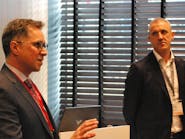Honeywell, Danfoss partner to connect drives and process control
As the processing industries push toward greater digital transformation and sustainability, the partnership between Honeywell and Danfoss aims to redefine how motor control and process automation systems work together. By integrating Danfoss’s variable frequency drives (VFDs) directly into Honeywell’s Experion Process Knowledge System (PKS), the two companies are working to enable a smarter, more connected and energy-efficient future for industrial operations.
“We continuously hear from customers about inefficiencies when they integrate the electrical scope, specifically VFDs, into process control,” explained Carlos Villa (left in image), modular system lead at Honeywell. “These inefficiencies often show up as increased CapEx and OpEx, as well as in process performance.”
The Honeywell-Danfoss collaboration directly addresses these challenges through the companies’ work to simplify VFD integration at the control level and unlock new streams of operational data that drive measurable improvements in reliability, energy efficiency and maintenance optimization.
The relationship builds on each company’s respective expertise. “Honeywell brings expertise on the process,” said Villa. “Danfoss is a global leader in motor control, and bringing those platforms together and integrating them at the Experion level is what we’re focused on.”
John Conboy (right in image), global sales and business development feader for Europe, Middle East and Africa at Danfoss Drives, noted that this is possible because drives have evolved far beyond being energy-saving devices. “We now see the drive as a sensor,” he said. “We have more sensors than ever in our drives, taking information from the grid, such as harmonics, voltage and current, and from the motor and driven load. And all of this data can be sent to Honeywell’s systems.”
Three phases of the Honeywell-Danfoss tech integration partnership
In their presentation at the 2025 Honeywell Users Group EMEA event in The Hague, Netherlands, Villa and Conboy explained that the Honeywell-Danfoss roadmap is unfolding across three key phases.
Phase one, which is already complete, focused on the integration between Danfoss VFDs and Honeywell Experion. “This involved mapping the basic functions, such as start, stop and jog into Experion, as well as basic monitoring capabilities produced by the drive,” said Villa. “We did this first to establish ease of integration before moving into the higher-value functions.”
Phase two, which is currently under development, expands the core integration aspects into asset management and predictive maintenance. “The aim here is to take information from the drive to determine critical events in operation and enable faster corrective actions,” explained Villa. “We’ll also use data from the drives to monitor the health of rotative assets, which gets us into predictive maintenance strategies.”
Conboy pointed out that, with condition-based monitoring, “we can perform vibration analysis of the motor, detect pump impeller damage, cavitation, and even early degradation of motor windings. Around 16% of motor failures are due to stator defects. And now, by measuring the current feedback, we can detect these issues up to 30 days in advance.”
These insights can reduce downtime by up to 45% and cut unplanned breakdowns by as much as 75%, said Conboy.
Phase three will focus on creating digital twins. Villa said the vision here is to integrate the simulation and digital twin capabilities of Honeywell with Danfoss drives to give users “rich information, not only about their control assets from a simulation perspective, but also from the perspective of the motor, the gearbox — the mechanical side of your plant’s devices.”
“This is where simulation and hardware-in-the-loop come into the discussion,” added Conboy. “We can test PLC code and the order sequence before we put a device into service. If you think about how much time is spent testing equipment before putting it into place, you’ll see that it can require days and even weeks of preparation. But with hardware-in-the-loop, your setup time can be reduced to about 15 minutes because we can fully replicate the grid, and the application, whether it be with a pump, fan or compressor. We can then create a mathematical model and bring that into the hardware-in-the-loop software and have real control from the drive testing all of these different elements before it goes into the field.”
Unlocking greater energy efficiency and sustainability
Conboy noted that a key pillar of the Honeywell-Danfoss partnership is sustainability. “At Danfoss, we say the greenest energy is the energy we don’t use,” he said. “With centrifugal loads like pumps and fans, a 20% reduction in speed creates a 50% reduction in energy. Yet today, only one in four motor applications in Europe use a VFD.”
Recent Danfoss research shows the scale of the opportunity: upgrading to more efficient IE2 and IE3 motors has saved Europe 12 terawatt hours, while deploying VFDs has saved 73 terawatt hours — but a staggering 153 terawatt hours remains untapped.
“That’s the annual energy consumption of Argentina sitting idle in European facilities,” Conboy said.
Danfoss drives also feature unique cooling technologies that further enhance energy efficiency and reliability. “Our heat pipe and back-channel cooling systems reduce the drive’s footprint and cut cooling requirements by up to 90%,” said Conboy. “That translates directly to lower energy costs and longer equipment life.”
Secure by design drives
With the increasing connectivity between operational technology (OT) and IT systems, cybersecurity is central to the two companies’ joint vision around their partnership. “With this level of connectivity between Danfoss drives and Honeywell’s Experion, cybersecurity becomes very important,” said Villa.
To explain how this is being handled down to the drive’s level, Conboy pointed to the Danfoss iC7-Automation drive family as being the industry’s first secure-by-design drive. “These drives feature a hardware crypto chip that protects firmware and ensures all communication is encrypted end-to-end,” he explained.
These drives also feature selectable protocols and come standard with SIL3-rated safe torque off and tamper-proof hardware.
About the Author
David Greenfield
Automation World
David Greenfield joined Automation World in June 2011. Bringing a wealth of industry knowledge and media experience to his position, David’s contributions can be found in AW’s print and online editions and custom projects. Earlier in his career, David was Editorial Director of Design News at UBM Electronics, and prior to joining UBM, he was Editorial Director of Control Engineering at Reed Business Information, where he also worked on Manufacturing Business Technology as Publisher.

